Traffic Prediction
Traffic prediction is the process of forecasting traffic conditions, such as congestion and travel times, using historical traffic data.
Papers and Code
A Theoretical Framework for Environmental Similarity and Vessel Mobility as Coupled Predictors of Marine Invasive Species Pathways
Nov 05, 2025Marine invasive species spread through global shipping and generate substantial ecological and economic impacts. Traditional risk assessments require detailed records of ballast water and traffic patterns, which are often incomplete, limiting global coverage. This work advances a theoretical framework that quantifies invasion risk by combining environmental similarity across ports with observed and forecasted maritime mobility. Climate-based feature representations characterize each port's marine conditions, while mobility networks derived from Automatic Identification System data capture vessel flows and potential transfer pathways. Clustering and metric learning reveal climate analogues and enable the estimation of species survival likelihood along shipping routes. A temporal link prediction model captures how traffic patterns may change under shifting environmental conditions. The resulting fusion of environmental similarity and predicted mobility provides exposure estimates at the port and voyage levels, supporting targeted monitoring, routing adjustments, and management interventions.
Beta Distribution Learning for Reliable Roadway Crash Risk Assessment
Nov 07, 2025Roadway traffic accidents represent a global health crisis, responsible for over a million deaths annually and costing many countries up to 3% of their GDP. Traditional traffic safety studies often examine risk factors in isolation, overlooking the spatial complexity and contextual interactions inherent in the built environment. Furthermore, conventional Neural Network-based risk estimators typically generate point estimates without conveying model uncertainty, limiting their utility in critical decision-making. To address these shortcomings, we introduce a novel geospatial deep learning framework that leverages satellite imagery as a comprehensive spatial input. This approach enables the model to capture the nuanced spatial patterns and embedded environmental risk factors that contribute to fatal crash risks. Rather than producing a single deterministic output, our model estimates a full Beta probability distribution over fatal crash risk, yielding accurate and uncertainty-aware predictions--a critical feature for trustworthy AI in safety-critical applications. Our model outperforms baselines by achieving a 17-23% improvement in recall, a key metric for flagging potential dangers, while delivering superior calibration. By providing reliable and interpretable risk assessments from satellite imagery alone, our method enables safer autonomous navigation and offers a highly scalable tool for urban planners and policymakers to enhance roadway safety equitably and cost-effectively.
MDAS-GNN: Multi-Dimensional Spatiotemporal GNN with Spatial Diffusion for Urban Traffic Risk Forecasting
Oct 31, 2025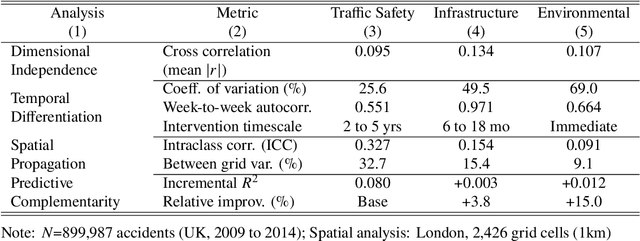
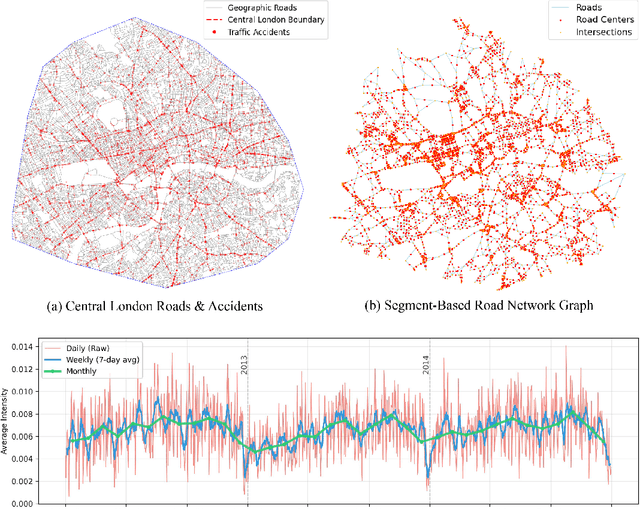
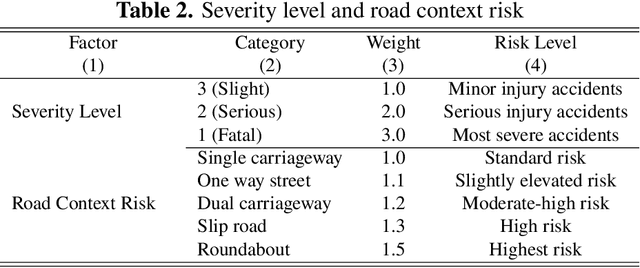
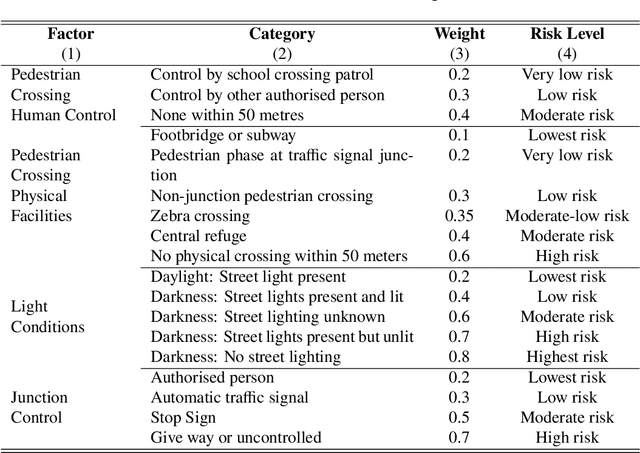
Traffic accidents represent a critical public health challenge, claiming over 1.35 million lives annually worldwide. Traditional accident prediction models treat road segments independently, failing to capture complex spatial relationships and temporal dependencies in urban transportation networks. This study develops MDAS-GNN, a Multi-Dimensional Attention-based Spatial-diffusion Graph Neural Network integrating three core risk dimensions: traffic safety, infrastructure, and environmental risk. The framework employs feature-specific spatial diffusion mechanisms and multi-head temporal attention to capture dependencies across different time horizons. Evaluated on UK Department for Transport accident data across Central London, South Manchester, and SE Birmingham, MDASGNN achieves superior performance compared to established baseline methods. The model maintains consistently low prediction errors across short, medium, and long-term periods, with particular strength in long-term forecasting. Ablation studies confirm that integrated multi-dimensional features outperform singlefeature approaches, reducing prediction errors by up to 40%. This framework provides civil engineers and urban planners with advanced predictive capabilities for transportation infrastructure design, enabling data-driven decisions for road network optimization, infrastructure resource improvements, and strategic safety interventions in urban development projects.
Pareto-Optimal Sampling and Resource Allocation for Timely Communication in Shared-Spectrum Low-Altitude Networks
Oct 30, 2025Guaranteeing stringent data freshness for low-altitude unmanned aerial vehicles (UAVs) in shared spectrum forces a critical trade-off between two operational costs: the UAV's own energy consumption and the occupation of terrestrial channel resources. The core challenge is to satisfy the aerial data freshness while finding a Pareto-optimal balance between these costs. Leveraging predictive channel models and predictive UAV trajectories, we formulate a bi-objective Pareto optimization problem over a long-term planning horizon to jointly optimize the sampling timing for aerial traffic and the power and spectrum allocation for fair coexistence. However, the problem's non-convex, mixed-integer nature renders classical methods incapable of fully characterizing the complete Pareto frontier. Notably, we show monotonicity properties of the frontier, building on which we transform the bi-objective problem into several single-objective problems. We then propose a new graph-based algorithm and prove that it can find the complete set of Pareto optima with low complexity, linear in the horizon and near-quadratic in the resource block (RB) budget. Numerical comparisons show that our approach meets the stringent timeliness requirement and achieves a six-fold reduction in RB utilization or a 6 dB energy saving compared to benchmarks.
Network-Constrained Policy Optimization for Adaptive Multi-agent Vehicle Routing
Oct 30, 2025Traffic congestion in urban road networks leads to longer trip times and higher emissions, especially during peak periods. While the Shortest Path First (SPF) algorithm is optimal for a single vehicle in a static network, it performs poorly in dynamic, multi-vehicle settings, often worsening congestion by routing all vehicles along identical paths. We address dynamic vehicle routing through a multi-agent reinforcement learning (MARL) framework for coordinated, network-aware fleet navigation. We first propose Adaptive Navigation (AN), a decentralized MARL model where each intersection agent provides routing guidance based on (i) local traffic and (ii) neighborhood state modeled using Graph Attention Networks (GAT). To improve scalability in large networks, we further propose Hierarchical Hub-based Adaptive Navigation (HHAN), an extension of AN that assigns agents only to key intersections (hubs). Vehicles are routed hub-to-hub under agent control, while SPF handles micro-routing within each hub region. For hub coordination, HHAN adopts centralized training with decentralized execution (CTDE) under the Attentive Q-Mixing (A-QMIX) framework, which aggregates asynchronous vehicle decisions via attention. Hub agents use flow-aware state features that combine local congestion and predictive dynamics for proactive routing. Experiments on synthetic grids and real urban maps (Toronto, Manhattan) show that AN reduces average travel time versus SPF and learning baselines, maintaining 100% routing success. HHAN scales to networks with hundreds of intersections, achieving up to 15.9% improvement under heavy traffic. These findings highlight the potential of network-constrained MARL for scalable, coordinated, and congestion-aware routing in intelligent transportation systems.
Enabling Reconfiguration-Communication Overlap for Collective Communication in Optical Networks
Oct 22, 2025Collective communication (CC) is widely adopted for large-scale distributed machine learning (DML) training workloads. DML's predictable traffic pattern provides a great oppotunity for applying optical network technology. Existing optical interconnects-based CC schemes adopt ``one-shot network reconfiguration'', which provisions static high-capacity topologies for an entire collective operation -- sometimes for a full training iteration. However, this approach faces significant scalability limitations when supporting more complex and efficient CC algorithms required for modern workloads: the ``one-shot'' strategies either demand excessive resource overprovisioning or suffer performance degradation due to rigid resource allocation. To address these challenges, we propose SWOT, a demand-aware optical network framework. SWOT employs ``intra-collective reconfiguration'' and can dynamically align network resources with CC traffic patterns. SWOT incorporates a novel scheduling technique that overlaps optical switch reconfigurations with ongoing transmissions, and improves communication efficiency. SWOT introduce a lightweight collective communication shim that enables coordinated optical network configuration and transmission scheduling while supporting seamless integration with existing CC libraries. Our simulation results demonstrate SWOT's significant performance improvements.
NetBurst: Event-Centric Forecasting of Bursty, Intermittent Time Series
Oct 25, 2025Forecasting on widely used benchmark time series data (e.g., ETT, Electricity, Taxi, and Exchange Rate, etc.) has favored smooth, seasonal series, but network telemetry time series -- traffic measurements at service, IP, or subnet granularity -- are instead highly bursty and intermittent, with heavy-tailed bursts and highly variable inactive periods. These properties place the latter in the statistical regimes made famous and popularized more than 20 years ago by B.~Mandelbrot. Yet forecasting such time series with modern-day AI architectures remains underexplored. We introduce NetBurst, an event-centric framework that reformulates forecasting as predicting when bursts occur and how large they are, using quantile-based codebooks and dual autoregressors. Across large-scale sets of production network telemetry time series and compared to strong baselines, such as Chronos, NetBurst reduces Mean Average Scaled Error (MASE) by 13--605x on service-level time series while preserving burstiness and producing embeddings that cluster 5x more cleanly than Chronos. In effect, our work highlights the benefits that modern AI can reap from leveraging Mandelbrot's pioneering studies for forecasting in bursty, intermittent, and heavy-tailed regimes, where its operational value for high-stakes decision making is of paramount interest.
Agentic AI meets Neural Architecture Search: Proactive Traffic Prediction for AI-RAN
Oct 01, 2025Next-generation wireless networks require intelligent traffic prediction to enable autonomous resource management and handle diverse, dynamic service demands. The Open Radio Access Network (O-RAN) framework provides a promising foundation for embedding machine learning intelligence through its disaggregated architecture and programmable interfaces. This work applies a Neural Architecture Search (NAS)-based framework that dynamically selects and orchestrates efficient Long Short-Term Memory (LSTM) architectures for traffic prediction in O-RAN environments. Our approach leverages the O-RAN paradigm by separating architecture optimisation (via non-RT RIC rApps) from real-time inference (via near-RT RIC xApps), enabling adaptive model deployment based on traffic conditions and resource constraints. Experimental evaluation across six LSTM architectures demonstrates that lightweight models achieve $R^2 \approx 0.91$--$0.93$ with high efficiency for regular traffic, while complex models reach near-perfect accuracy ($R^2 = 0.989$--$0.996$) during critical scenarios. Our NAS-based orchestration achieves a 70-75\% reduction in computational complexity compared to static high-performance models, while maintaining high prediction accuracy when required, thereby enabling scalable deployment in real-world edge environments.
Biased-Attention Guided Risk Prediction for Safe Decision-Making at Unsignalized Intersections
Oct 14, 2025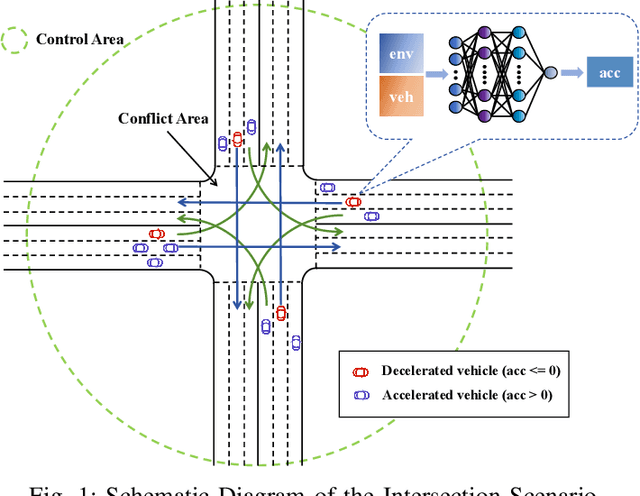
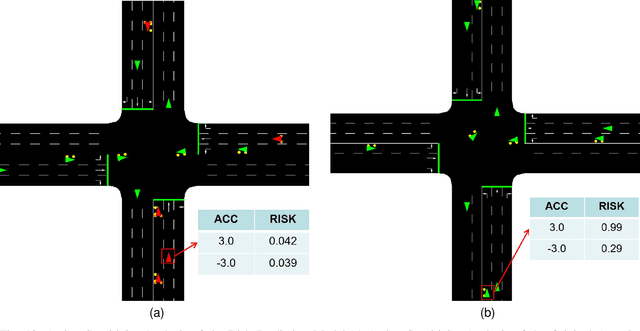

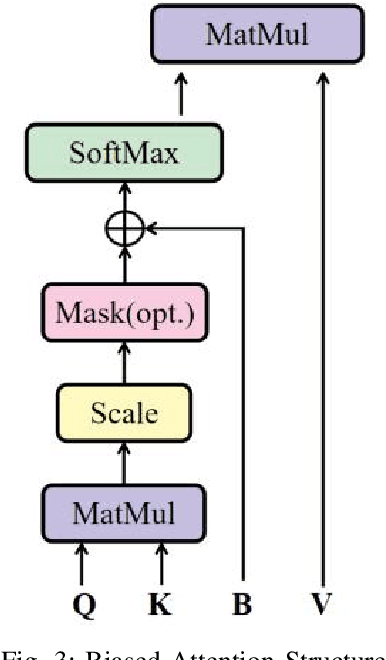
Autonomous driving decision-making at unsignalized intersections is highly challenging due to complex dynamic interactions and high conflict risks. To achieve proactive safety control, this paper proposes a deep reinforcement learning (DRL) decision-making framework integrated with a biased attention mechanism. The framework is built upon the Soft Actor-Critic (SAC) algorithm. Its core innovation lies in the use of biased attention to construct a traffic risk predictor. This predictor assesses the long-term risk of collision for a vehicle entering the intersection and transforms this risk into a dense reward signal to guide the SAC agent in making safe and efficient driving decisions. Finally, the simulation results demonstrate that the proposed method effectively improves both traffic efficiency and vehicle safety at the intersection, thereby proving the effectiveness of the intelligent decision-making framework in complex scenarios. The code of our work is available at https://github.com/hank111525/SAC-RWB.
HyPlan: Hybrid Learning-Assisted Planning Under Uncertainty for Safe Autonomous Driving
Oct 08, 2025We present a novel hybrid learning-assisted planning method, named HyPlan, for solving the collision-free navigation problem for self-driving cars in partially observable traffic environments. HyPlan combines methods for multi-agent behavior prediction, deep reinforcement learning with proximal policy optimization and approximated online POMDP planning with heuristic confidence-based vertical pruning to reduce its execution time without compromising safety of driving. Our experimental performance analysis on the CARLA-CTS2 benchmark of critical traffic scenarios with pedestrians revealed that HyPlan may navigate safer than selected relevant baselines and perform significantly faster than considered alternative online POMDP planners.
 Add to Chrome
Add to Chrome Add to Firefox
Add to Firefox Add to Edge
Add to Edge